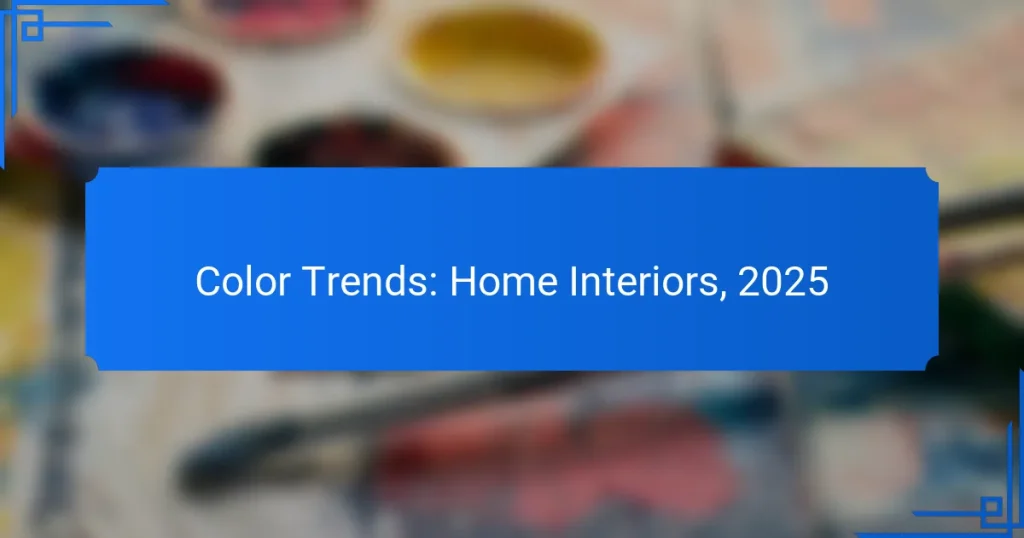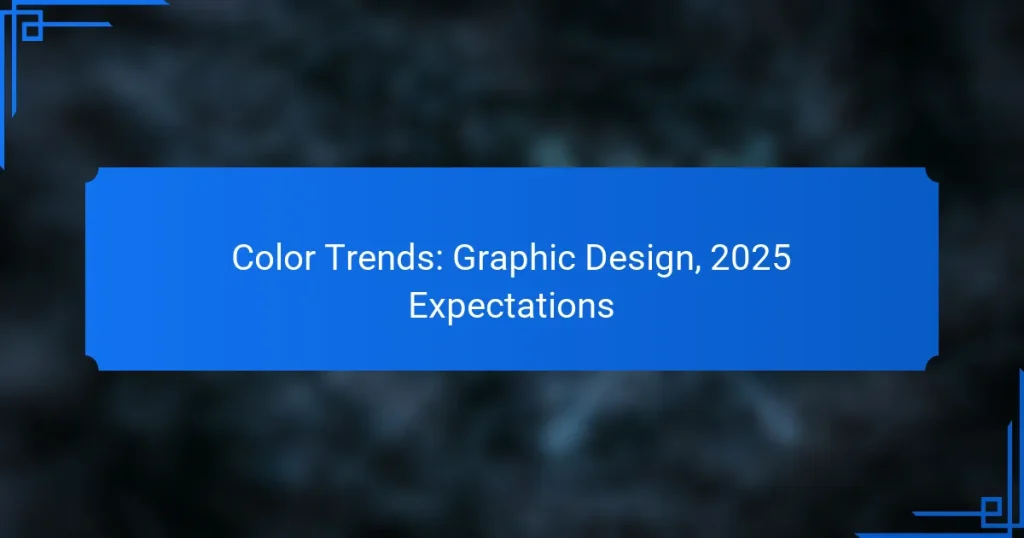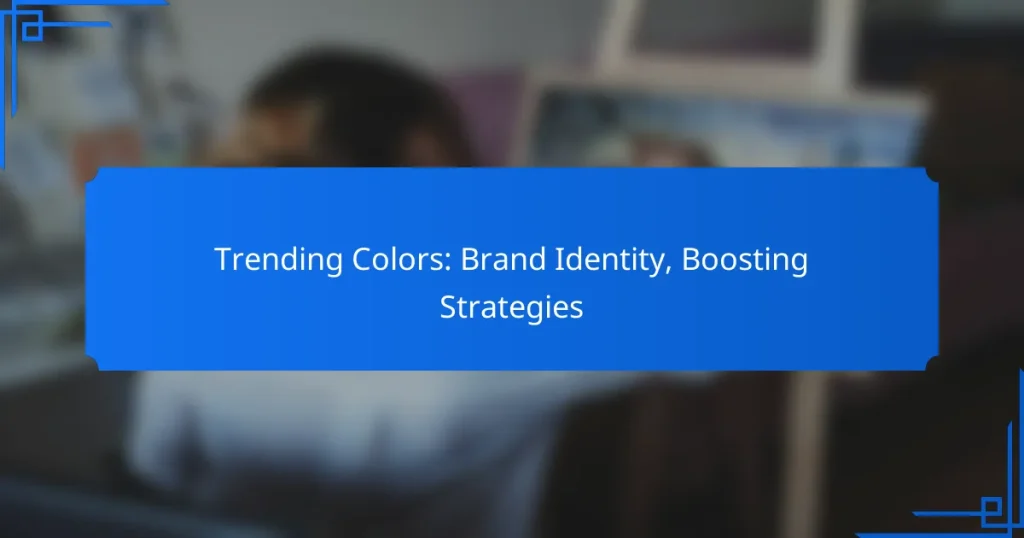Color trends in 2023 showcase a dynamic mix of bold hues, earthy tones, and soft pastels, catering to a wide range of styles and preferences. These trends influence various fields, including fashion, interior design, and graphic arts, shaping how individuals express their identities through color. Understanding and incorporating these trends can significantly enhance the visual appeal of designs, making them more impactful and relevant.
Color Trends: Home Interiors, 2025
Pantone Color of the Year: Incorporation Strategies, Wardrobe Ideas
Color Trends: Digital Marketing, Small Business Strategies
Color Trends: Graphic Design, 2025 Expectations
Trending Colors: Brand Identity, Boosting Strategies
What Are the Current Color Trends in 2023?
In 2023, color trends emphasize bold and vibrant hues, earthy tones, and soft pastels, reflecting a diverse palette that caters to various tastes and styles. These trends can be seen in fashion, interior design, and graphic arts, influencing how individuals express themselves through color choices.
Bold and Vibrant Colors
Bold and vibrant colors are making a strong statement in 2023, with shades like electric blue, fiery red, and bright yellow dominating the scene. These colors evoke energy and confidence, making them ideal for attention-grabbing designs.
When incorporating bold colors, consider using them as accent shades against neutral backgrounds to create a balanced look. For example, a bright orange sofa can stand out beautifully in a room painted in soft gray.
Earthy Tones
Earthy tones, such as terracotta, olive green, and warm beige, are trending as they bring a sense of calm and connection to nature. These colors are particularly popular in home decor, where they create a cozy and inviting atmosphere.
To effectively use earthy tones, combine them with natural materials like wood and stone. This combination enhances the organic feel and can be particularly appealing in spaces like living rooms and kitchens.
Pastel Shades
Pastel shades, including soft pinks, light blues, and gentle lavenders, are favored for their soothing qualities. These colors are often used in fashion and branding to convey a sense of tranquility and approachability.
When choosing pastels, consider pairing them with white or light gray to maintain a fresh and airy feel. For instance, a pastel blue dress can be complemented with white accessories for a balanced look.
Neon Accents
Neon accents are making a comeback, adding a playful and modern twist to designs. Bright neon colors like hot pink, lime green, and electric orange are often used sparingly to create striking focal points.
To incorporate neon accents effectively, use them in small doses, such as in accessories or artwork, to avoid overwhelming a space. A neon sign or a few decorative pillows can add just the right amount of pop without dominating the overall aesthetic.
Monochromatic Palettes
Monochromatic palettes, which utilize varying shades of a single color, are gaining popularity for their sophisticated and cohesive look. This approach allows for depth and interest while maintaining a unified theme.
When designing with a monochromatic palette, experiment with different textures and patterns to add dimension. For example, using various shades of blue in a room can create a serene environment while still being visually engaging.
How to Incorporate Color Trends into Design?
Incorporating color trends into design involves understanding current color palettes and effectively applying them to enhance visual appeal. By leveraging color theory, audience preferences, and branding strategies, designers can create impactful and relevant designs.
Use Color Theory Principles
Color theory principles guide the selection and combination of colors to create harmony and contrast in design. Understanding concepts like complementary colors, analogous colors, and the color wheel can help in making informed choices that resonate with viewers.
For example, using complementary colors can create a vibrant look, while analogous colors provide a more serene and cohesive feel. Designers should consider the emotional impact of colors, as different hues can evoke specific feelings and responses.
Consider Target Audience Preferences
Understanding the preferences of your target audience is crucial when incorporating color trends. Different demographics may respond differently to colors based on cultural associations, age, and personal tastes.
Conducting surveys or focus groups can provide insights into which colors resonate best with your audience. For instance, younger audiences might prefer bold and vibrant colors, while older demographics may lean towards muted and classic tones.
Apply Trends to Branding
When applying color trends to branding, consistency is key. Brands should integrate trending colors into their visual identity while ensuring they align with their core values and message.
For example, a tech company might use sleek, modern colors like blues and grays to convey innovation, while a wellness brand might opt for earthy tones to evoke a sense of calm and naturalness. Regularly updating color schemes in marketing materials can keep the brand fresh and relevant.
What Are the Best Tools for Color Selection?
The best tools for color selection help designers and artists create harmonious color palettes efficiently. These tools offer features like color wheel manipulation, palette generation, and community sharing to enhance creativity and streamline the design process.
Adobe Color
Adobe Color is a powerful online tool that allows users to create and explore color schemes based on various color theory principles, such as complementary and analogous colors. Users can start from scratch or extract colors from images, making it versatile for different design needs.
One of its standout features is the ability to save palettes to your Adobe Creative Cloud account, enabling seamless integration with applications like Photoshop and Illustrator. This connectivity can save time and enhance workflow for professionals who rely on Adobe products.
Coolors
Coolors is a user-friendly color scheme generator that allows users to quickly create, save, and share color palettes. With a simple click, you can generate a new palette or lock in colors you like, making it easy to experiment with different combinations.
Coolors also offers a feature to explore trending palettes and color combinations, which can inspire new ideas. Additionally, it provides options to export palettes in various formats, making it convenient for web and graphic design projects.
Canva Color Palette Generator
The Canva Color Palette Generator is an intuitive tool that helps users create color palettes from images or by selecting colors manually. By uploading an image, the tool automatically extracts dominant colors, which can be a great starting point for design projects.
This generator is particularly useful for those who use Canva for their design work, as it allows for easy integration of chosen colors into their projects. Users can also save their palettes for future use, ensuring consistency across designs.
How Do Color Trends Affect Consumer Behavior?
Color trends significantly influence consumer behavior by shaping perceptions and emotional responses. When brands align their products with current color trends, they can enhance appeal and drive purchasing decisions.
Emotional Responses to Colors
Colors evoke specific emotions that can affect how consumers feel about a brand or product. For instance, blue often conveys trust and reliability, making it a popular choice for financial institutions, while red can evoke excitement and urgency, commonly used in sales promotions.
Understanding the emotional impact of colors can help brands tailor their marketing strategies. For example, a brand targeting a youthful audience may use vibrant colors like orange or lime green to convey energy and creativity.
Impact on Purchasing Decisions
Color trends can directly impact purchasing decisions by influencing how consumers perceive value and quality. Products that feature trendy colors may be seen as more desirable, leading to increased sales. For instance, seasonal color palettes can drive consumers to purchase items they may not have considered otherwise.
Brands should consider incorporating popular colors into their product lines or marketing materials to attract attention. However, it’s essential to balance trendiness with brand identity to maintain consistency and avoid alienating loyal customers.
What Are the Historical Color Trends?
Historical color trends reflect the evolving tastes and cultural influences over time. They often reveal societal values, technological advancements, and artistic movements that shaped the use of color in design and fashion.
Color Trends of the 1980s
The 1980s were characterized by bold, vibrant colors and a mix of styles that embraced both neon and pastel shades. Popular colors included hot pink, electric blue, and bright yellow, often used in fashion, interior design, and graphic arts.
This decade saw the rise of pop culture icons and music genres that influenced color choices, such as punk rock and new wave. Designers like Gianni Versace and brands like Swatch popularized these vivid palettes, making them synonymous with the era.
When incorporating 1980s color trends today, consider using bright accents in moderation to avoid overwhelming spaces. Pairing bold colors with neutral tones can create a balanced look that pays homage to this iconic decade without feeling dated.





